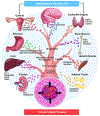Mechanisms of Vascular Aging, A Geroscience Perspective: JACC Focus Seminar
- PMID: 32130929
- PMCID: PMC8559983
- DOI: 10.1016/j.jacc.2019.11.061
Mechanisms of Vascular Aging, A Geroscience Perspective: JACC Focus Seminar
Abstract
Age-related pathological alterations of the vasculature have a critical role in morbidity and mortality of older adults. In epidemiological studies, age is the single most important cardiovascular risk factor that dwarfs the impact of traditional risk factors. To develop novel therapeutic interventions for prevention of age-related vascular pathologies, it is crucial to understand the cellular and molecular mechanisms of vascular aging. In this review, shared molecular mechanisms of aging are considered in terms of their contribution to the pathogenesis of macrovascular and microvascular diseases associated with old age. The role of cellular senescence in development of vascular aging phenotypes is highlighted, and potential interventions to prevent senescence and to eliminate senescent cells for prevention of vascular pathologies are presented. The evidence supporting a role for interorgan communication and circulating progeronic and antigeronic factors in vascular aging is discussed.
Keywords: atherosclerosis; endothelial dysfunction; geroscience; microcirculation; senescence.
Copyright © 2020 American College of Cardiology Foundation. Published by Elsevier Inc. All rights reserved.
Figures



References
-
- Lakatta EG, Levy D. Arterial and cardiac aging: major shareholders in cardiovascular disease enterprises: Part I: aging arteries: a “set up” for vascular disease. Circulation 2003;107:139–46. - PubMed
Publication types
MeSH terms
Grants and funding
LinkOut - more resources
Full Text Sources
Medical

